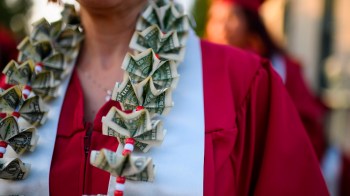Debt, n. An ingenious substitute for the chain and whip of the slave-driver. Ambrose Bierce, The Devil’s Dictionary
The student loan debt burden is getting worse. The epicenter of trouble is so-called private student loans and it’s where policymakers should focus their attention. It’s time to take action on private student loans. Take the dismaying experience of Daniel in Stillwater, Okla.
I am a first-generation college graduate, and I desperately need your help. I am a borrower of over $108,000 in student loans, the vast majority of which are private loans. I pay more than $1,100 per month to my student loan creditors on a gross annual salary of just $32,500 and I’ve run into serious trouble with one lender (which accounts for $50,000 of my student loan debt). I’ve been living constantly on the precipice of financial disaster ….
Yes, looking at his story, Daniel made a couple of mistakes that ended up ballooning the cost of his education. But they were understandable ones that ended up saddling him with way too much debt for his degree from the University of Tulsa. Now what? He turned to the Consumer Credit Counseling Services of Oklahoma, but the nonprofit organization couldn’t do anything since the problem was student loans. A government-led consolidation wasn’t an option since the bulk of his debt is private student loans. He left the nonprofit job he loved (earning $29,000) in Tulsa and moved to Stillwater for a better paying job at $32,500. He’s living on little. Lenders won’t realistically negotiate with him. The bill collectors are calling.
A couple weeks ago, I met with a bankruptcy attorney to discuss Chapter 13 bankruptcy, which had been explained to me as a way for a judge to listen to the case and create a repayment plan that would work with my budget. I broke down when he told me even that wasn’t an option in my case. Let me be clear: I don’t want to pay less than I borrowed. I don’t want to “settle” my account for less than I owe and I don’t expect the loans to simply disappear. … But I need to be able to live, to eat, to pay rent, buy gasoline and get my hair cut. … If there’s a way out of this mess, I haven’t found it.
Problem is, there really isn’t a way out because private student loans can’t be discharged in bankruptcy. Now, there are good reasons why borrowers can’t get rid of their federal student loans. They’re backed by taxpayers and they deserve their money back. Federal student loans come with a number of critical protections, including deferment, forbearance, and several repayment options that lower the monthly tab. I think the way we now pay for college relies far too much on debt. There are a number of good reform proposals that should be seriously considered, such as relying on equity rather than debt financing. It’s an ideas I’ve explored a number of times, such as here and here.
It’s a different story with private student loans. They’re really relabeled consumer loans and if you look at where the genuine repayment problems tend to rest, it’s with private student loans. Debts should be repaid, of course. And most people do pay back their loans. Still, students like Daniel used to be able to get rid of their private student loans in bankruptcy if the burden was too great and the borrower needed a fresh start. The law changed with the Bankruptcy Reform Act of 2005. Big mistake.
Daniel is far from alone. “Evidence is mounting that student loans could be the next trouble spot for lenders,” says Dr. Andrew Jennings, chief analytics officer at FICO and head of FICO Labs.
The National Association of National Association of Consumer Bankruptcy Attorneys issued a report, The Student Loan “Debt Bomb”: America’s Next Mortgage-Style Economic Crisis. “Take it from those of us on the front line of economic distress in America,” says William E. Brewer, Jr., president, NACBA. “This could very well be the next debt bomb for the U.S. economy.”
The amount of student borrowing crossed the $100 billion threshold in 2010. The total outstanding loans exceeded $1 trillion for the first time last year. The trend shows no sign of abating. For instance, consumer credit soared by $19.3 billion in December, largely reflecting a big jump in student loans (which accounted for nearly two-thirds of the monthly change). An NACBA survey of 860 bankruptcy attorneys nationwide found that:
More than four out of five bankruptcy attorneys (81 percent) say that potential clients with student loan debt have increased “significantly” or “somewhat” in the last three-four years. Overall, about half (48 percent) of bankruptcy attorneys reported significant increases in such potential clients.
Nearly two out of five of bankruptcy attorneys (39 percent) have seen potential student loan client cases jump 25-50 percent in the last three-four years. An additional quarter (23 percent) of bankruptcy attorneys have seen such cases jump by 50 percent to more than 100 percent.
Policymakers shouldn’t be complacent about private student loans. The warning signs are there. In the meantime, parents and their students need to be wary of the amount of debt they take on to pay for college.
There’s a lot happening in the world. Through it all, Marketplace is here for you.
You rely on Marketplace to break down the world’s events and tell you how it affects you in a fact-based, approachable way. We rely on your financial support to keep making that possible.
Your donation today powers the independent journalism that you rely on. For just $5/month, you can help sustain Marketplace so we can keep reporting on the things that matter to you.

















